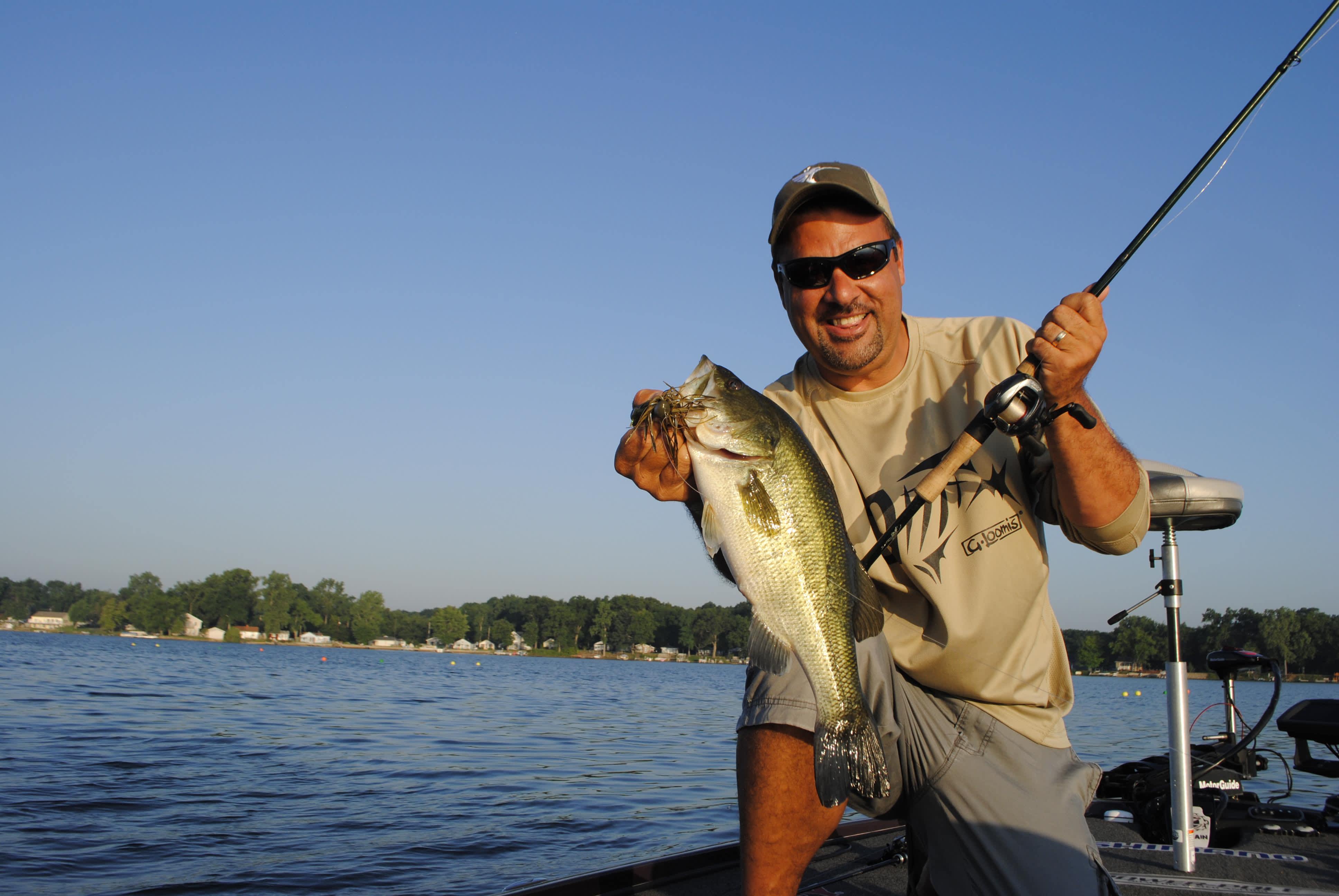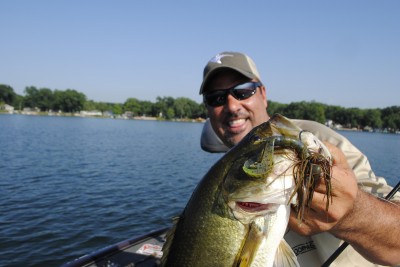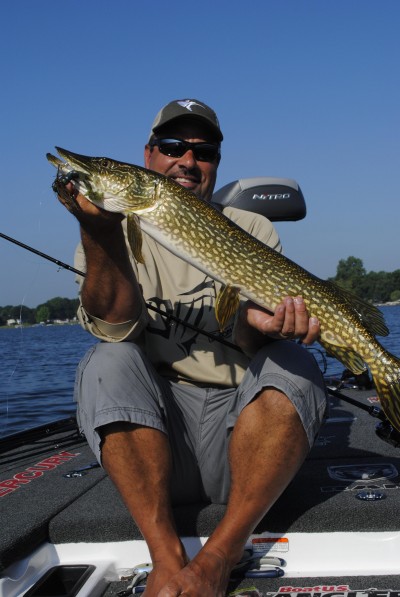The Rules of Bass Attraction
Bob Gwizdz 08.12.13

There are two rules about bass fishing in the hottest part of the summer, says Mark Zona: the 12-foot rule and the 15-foot rule.
The 12-foot rule, Zona says, is what most anglers follow. They fish 12 feet of water or less.
“You’ll catch small fish and get just enough to keep you there and then all of a sudden you’ll catch a good one and then you’ll stay there all day,” Zona explained. “But most of his relatives–especially the big ones–are out behind your boat.”
The 15-foot rule? Simple: “I never want my bait to hit the bottom in less than 15 feet,” Zona said. “Ever.”
As it was, Zona had his boat out in 32 feet of water on a hot, sunny summer day on a smallish lake in Michigan’s St. Joseph County. We were casting into shallower water (and by shallower, I expect it was at least 25 feet) and bringing it back through the sand grass on the bottom. And we were catching largemouths, good ones.
We were fishing with big (3/4-ounce or one ounce) football-shaped jigs dressed with big, bulky Strike King Rage Craw trailers. We wanted big baits, Zona said, to attract big bites. And we wanted something that fell like a cinder block in the water column so the fish didn’t have time to decide, they just had time to react.
“The fish are out here and will stay here until mid-September to late October, when they move back in,” Zona said. “Then they’ll come back out here around deer season and stay the rest of the year.

“I’ll bet the bass spend 70 percent of their time in this zone. They’re like a big deer–they want a food source, comfort, and safety. It’s the same principle. The only time they get stupid is when they breed.”
We made long casts–“you want to cover expansive areas of contour,” Zona said–with medium-heavy baitcasting rods and 15-pound fluorocarbon line.
“You want a fast, fast reel, too,” Zona said. “Once you stick them you have to keep that line tight. If you give them just a hair of not being on that reel, they’ll throw that jig in a second.”
Indeed. I jumped off a four-pound-class largemouth that had hit on the fall of a long cast. It got just enough slack on me to use that heavy jig as a lever and throw it.
“With 15-pound test line the jig still gets a fast rate of fall–a bullet effect–but if you keep it tight, you’ll lose very few fish. You don’t want to go any lighter, they’ll break you off. And if you use much heavier line it slows down the rate of fall.”
A television guy, Zona is the co-host of The Bassmasters on ESPN and host of Zona’s Amazing Fishing Show on the Outdoor Channel. He does a lot of bass fishing, both in front of the camera and away from it, and talks a lot of bass fishing the same way in between. I’ve known him since he was a college kid; he has always been a good fisherman.
Our jigs would occasionally hang up in the grass on the bottom and, when they did, we’d pop them free. The strike often came on the drop after you snapped it up. Zona’s theory is that the bass are down there eyeballing it and when it lurches up and then down quickly, they can’t help themselves.
One key, Zona said, is to make sure you’re picking up the slack line as it’s falling so you can feel that strike.
“Always follow it down,” he said. “Always.”
In four hours we put a dozen nice bass in the boat. None of them were babies. And just as interesting–and perhaps more unique–were the pike bites. We had six; we boated two fish, had three break off (not unusual when fishing without steel leaders for those toothy critters), and one that just pulled off. But the pike were just out there intermingled with the bass.

For instance, on one cast Zona hooked a 3-1/2-pound largemouth and as he brought it in, he practically fell out of the boat watching another bass (one he guessed at seven pounds) try to take the jig away from his. As soon as he boated it, I fired a cast out to where Zona had hooked up, felt a tick on the initial drop, set the hook, and my rod bent into a parabola. Zona started hooting that I’d hooked the big one.
But as I reeled it in, it never came to the surface and when I got it to the boat–but still about four feet down–we saw a pike as long as my leg. Zona guessed it at 18 or 19 pounds. But when I started to pull it to the surface, the line parted like so much sewing thread. Rats.
Zona said his deep-water technique with big, fast-falling baits doesn’t produce as well in dark or murky water as it does in the crystal-clear stuff and that you sometimes have to cover a lot of water before you find fish.
“There’s a lot of dead time doing this,” he said. “But generally speaking, where you find one, you find the crop.”
That seemed so. All of our bites came from a few small areas. But every one of them was a keeper. No doubt we’d have won the tournament that day.
When it comes to catching big bass in the summer, Zona said, there’s a simple moral to the story:
Forget the 12-foot rule and adhere to the 15-foot version.
For more information on Michigan fishing go to michigan.org. Click here to purchase a Michigan fishing license online.

